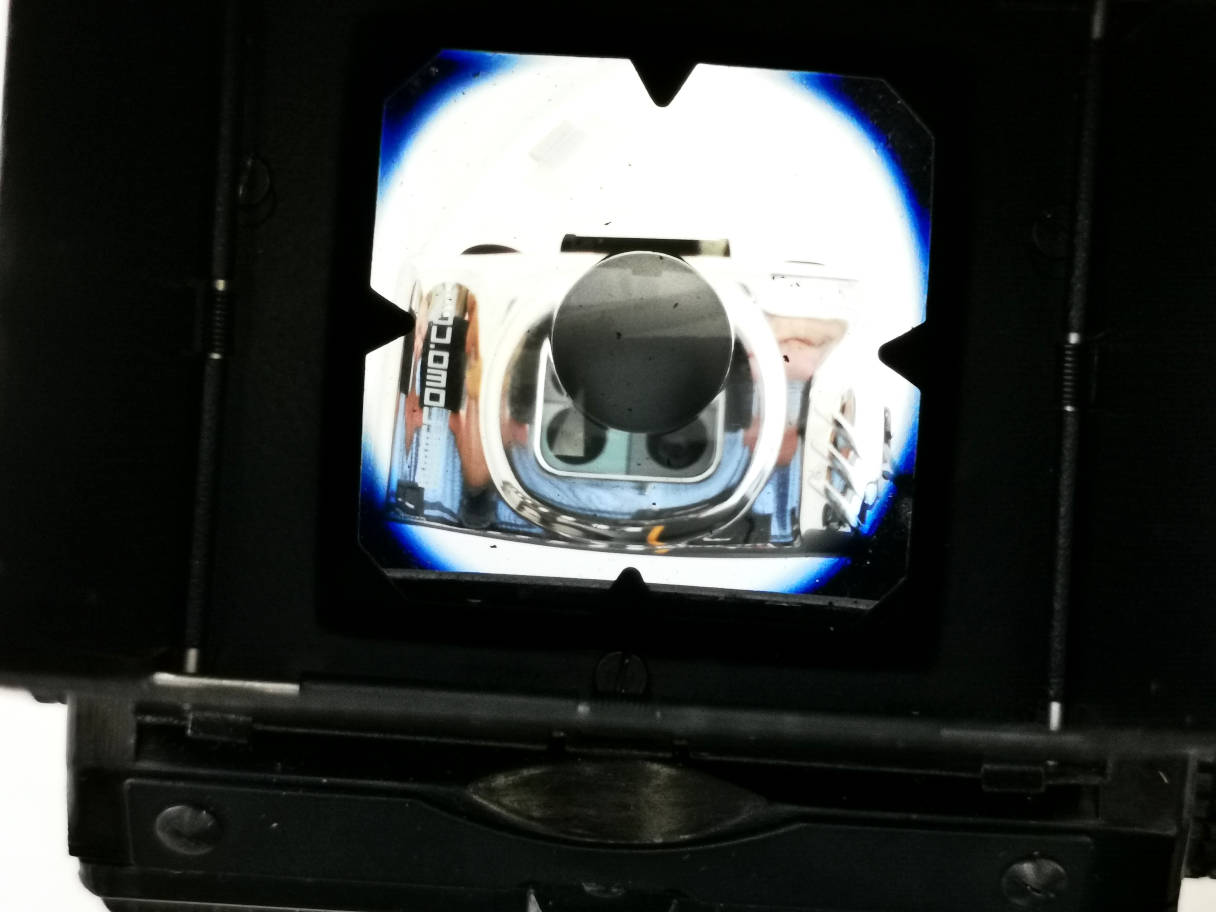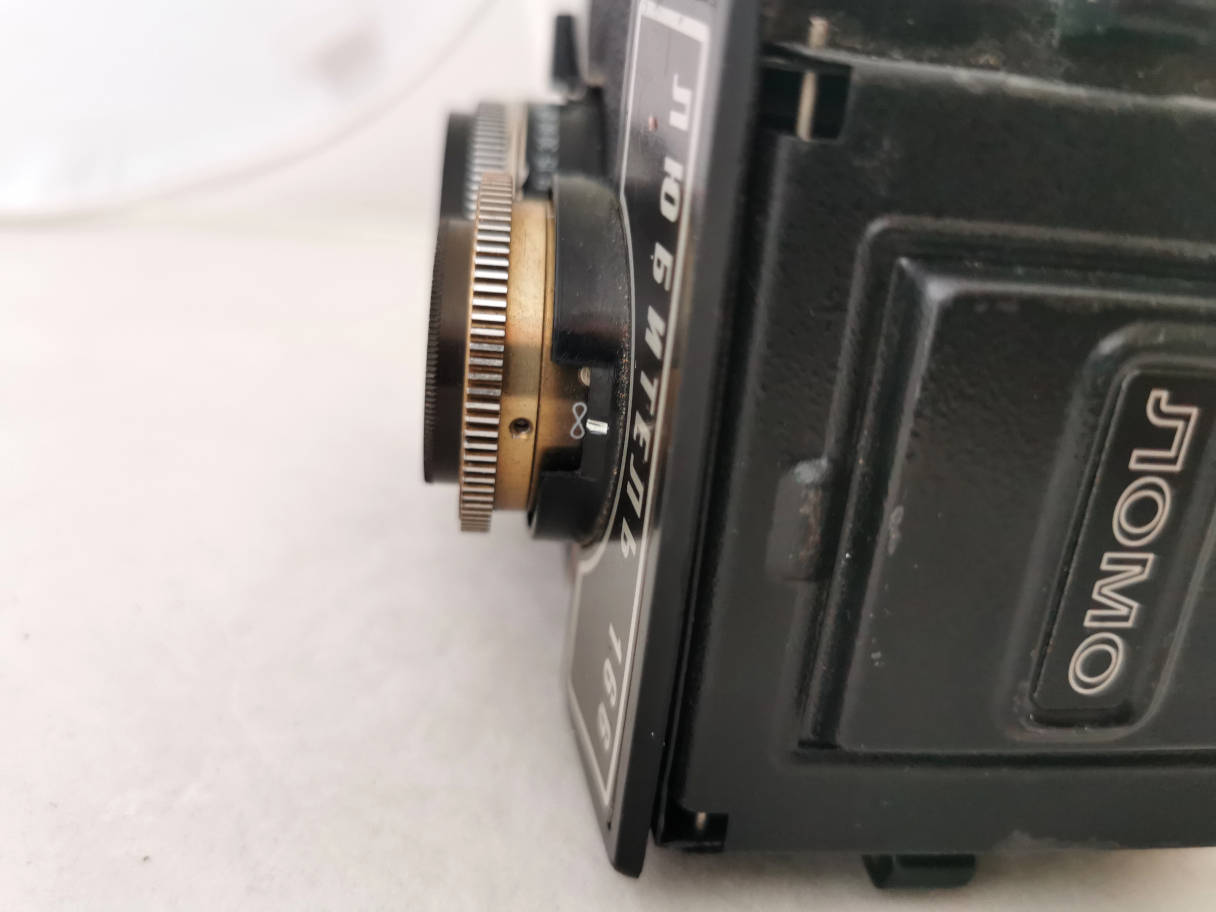OddCameras.com Lubitel 166 Olympic
The Lubitel 166 Olympic is a Twin Lens Reflex
6x6 camera, made by LOMO, production began in 1976. It is an update of
the Lubitel 2. It has a redesigned housing, a hot shoe and, most
important, it has an automatic film advance with an automatic frame
counter. It is the first of the series to bear the Lomo name and has a
badge for the Olympic Games in Moskow in 1980.
Obviously there were problems with the hot shoe as with the frame
counter, so only 69.000 were made. It was followed in 1980 by the 166B
which has no hot shoe and no counter.
To give an idea of the whole series of the GOMZ/LOMO cameras in historical order:
-Komsomolets 1946-1951, predecessor of the Lubitel. Unlike the Lubitel,
it has a non-focussing viewfinder. It is a close copy of the
Voigtländer Brillant. 300.000 were made.
-Lubitel TLR 1950-1956, focussing finder like the Voigtländer Brillant S. 1.300.000 were made.
-Lubitel-2 1955-1977, improved version. 2.200.000 were made.
-Lubitel-166 1977-1980, so-called Olympic version, much improved, see above. Quality problems. Only 69.000 were made.
-Lubitel-166 B 1980-1990, downgraded version, no hot shoe, no counter and automatic film advance. 900.000 were made.
-Lubitel-166 Universal 1983-1996 (end of production), A 4.5x6 mask was added, 400.000 were made.
-Lubitel-166+ 2008-?, relaunch based on the 166 universal (manufactured for Lomographic Society).
The camera presented is a rare Lubitel 166 Olympic.
Lenses:
Taking lens: LOMO T-22 1:4.5 f=75mm, coated
Viewing lens: unnamed,
Shutter: leaf, 1/15 to 1/250s, diaphragms 4.5 to 22.
Some pictures:

Camera with double cap, a faux leather case and a Russian Svema film.

Camera
front.

Camera
back. The camera doesn't need a red window. There is a film reminder to hide the red window.

Camera right side. Hot shoe and 2 pegs.

Camera
left side. Wind knob, film counter and one peg. On the lens barrel: speed and aperture setting. Near the bottom: shutter lever.

Camera open.

Sports finder.

Luminous screen with focussing area.

A loupe is provided.

Camera back open.

Film wind chamber.

Film spool chamber.
Some pictures of a slighty different version:

It has a a burnished advance knob instead of a black one

...and a lens barrel...

...that is burnished instead of black as well.

It has a late 1980 serial number.
The
camera is very light and very small. Handling is easy an logic. To put
a film, lift the tab at the top and open the back. There is one
peg to retract for the film wind spool and the wind knob retracting is
sometimes a bit difficult, but if you insist and wiggle a little, it retracts.
Put the film supply spool in its
compartment at the bottom, there are 2 pegs to retract, that's a lot
easier. Engage the paper leader into the winding spool.
As long as there is no film in the supply side, the camera only winds
half a turn and stops. You have to to release the shutter to wind a
further half turn. As soon as the film is in the supply side, you can
wind further. The first half turn is easy, then there is a certain
friction, but you can wind on if your camera is not defective. But
there are a lot of cameras around that don't wind the normal way. In
this case, see further below.
Wind until
the big arrow on the paper meets the 2 white dots near the top. Close
the back and wind until number 1 appears and it stops. Open the viewer,
set speed and aperture, focus via the sccreen, compose your photo and
take your picture. Wind to the next. When all 12 photos are taken, wind
on a few turns, open the back and pry the spool out of its chamber.
The
camera lacks slow speeds, but there is a B setting. Closest focus is 1.3m, that's not very close. Picture quality is very good.
The film advance is often a problem. The knob only winds half a turn
and stops. As said, this is OK when there is no film in the camera. If it keeps
stopping with film in it, there is a way around this if you have the
cap: put the cap
and wind and release until number 1 just shows. Take your photo. Put
the cap again, wind and release 2 times and wind again. Take the next
photo. After the 4th photo, it's only one wind and release and a second
wind between the photos as the spool become thicker. Do not forget to
put the cap! Worked fine on one of mine. But as mine had also leaks near the
lens, I gave up. Working correctly it is a nice camera. So be
sure to buy a camera that has been tested with real film.
I have bought 6 of these, all said to be working. The first 4 did not work. I could
not send back the one from Russia. 2 of them I sent back to the seller.
The 4th was refunded, but the kind seller offered me the defective
camera. The 5th I could finally get working. Please read the last part of the page.
I sought help on the web and on special forums for the film advance, but
I found and got nothing. So I took the 2 non-working cameras apart. There are only
6 screws, all on the wind knob side, which are hidden under patches of
plastic covering, easily visible. Pry the patches out and keep them.

There is some glue on the screw heads, easily to be scraped off with a sharp screwdiver.
Take out the screws. Take off the advance knob. If you turn it in the
wrong direction, it comes off, the part that engages into the film
spool will fall off into the film chamber. Now you can lift the lid and
turn it round the lower peg. You can also screw off the peg, but that's
more difficult and it's not necessary.

This is the mechanism. This one has 2 defaults: a spring is missing
between the rachet mechanism on top (you see a bit of wire still in
place) and the big arm that goes from middle right to the counter wheel
down left. And the counter does not go back to zero, it stops between 8
and 9.
There are only 3 silver screws that hold the mechanism, one on top to the right and 2 in the middle to left and right.

If you take them out, you can lift the whole mechanism. Note that I put
the missing spring (has to be re-arranged so that it goes into the
slit, but it works for testing) and that I re-screwed the advance knob.

Seen from the other side. The pin top right is pushed in when the back
cover is shut. The finely toothed wheel bottom right is moved by the
paper of the advancing film. The saw-like bar towards the bottom cocks
the shutter via moving a gear wheel of the shutter mechanism
If you have a steady hand, you can take off the counter wheel.

The counter wheel base in place and the counter wheel lid taken off.
There is a little spring around the axis. It has a tiny, tiny arm that
you have to pry out of the space between the axis and the ring and then
put it into one of the 4 slits of the ring. Then you have to tension
the base by making at least one turn, put the lid back and fasten the
center screw. There are 2 little pastic pins on the counter wheel base
which hold another spring. One is a little bit longer and goes into the
hole at the number 7 of the counter wheel lid.
I managed to to get it working, it returns to zero now. But it's very fiddly and I could not take photos while doing it.
That's it for the moment. I have now 2 mechnisms that seem to work.
There is no corrosion or lack of oil. But when I put them back, the
camera still doesn't work. Even worse: shutter cocking is now erratic,
it was OK before. I am missing something. But I will try to find out...
Any help or suggestions are welcome.
Update 1:
I got a 5th camera from Ukraine, in spite of the war devastating the
country. Ukrainian Post tried hard and moved the parcel several times
around the country to get it out. It arrived after more than 2 months.
This camera feels a bit different. I cannot say if it is regular, but
at least it works correctly. Maybe this can help you with yours.
If there is no film in the camera, winding stops after half a turn. A rock solid stop. You have to release the shutter to be able to wind again. If
you put a film into the supply chamber and try to wind the film leader
onto the upper spool, it still seems to stop, but against quite some
friction you can wind on. Maybe there was less friction when the camera
was new. After closing the back you wind on until number 1 appears.
Then it stops for good. Take your photo and wind again, the first half
turn is easy and arms the shutter, but again you can wind further
against friction until the next number appears and it stops for good.
So my camera works. If you have a camera that does the same, please
confirm to me so that I can spread the information. Thank you.
Update 2:
I bought a 6th camera from a collector's heritage, this one seems to be
unused. It's a 1980 model as well. It works fine. There is nearly the
same amount of friction when winding on. So let us suppose that the
friction is normal. If you have one that has no friction, please let me
know.




















